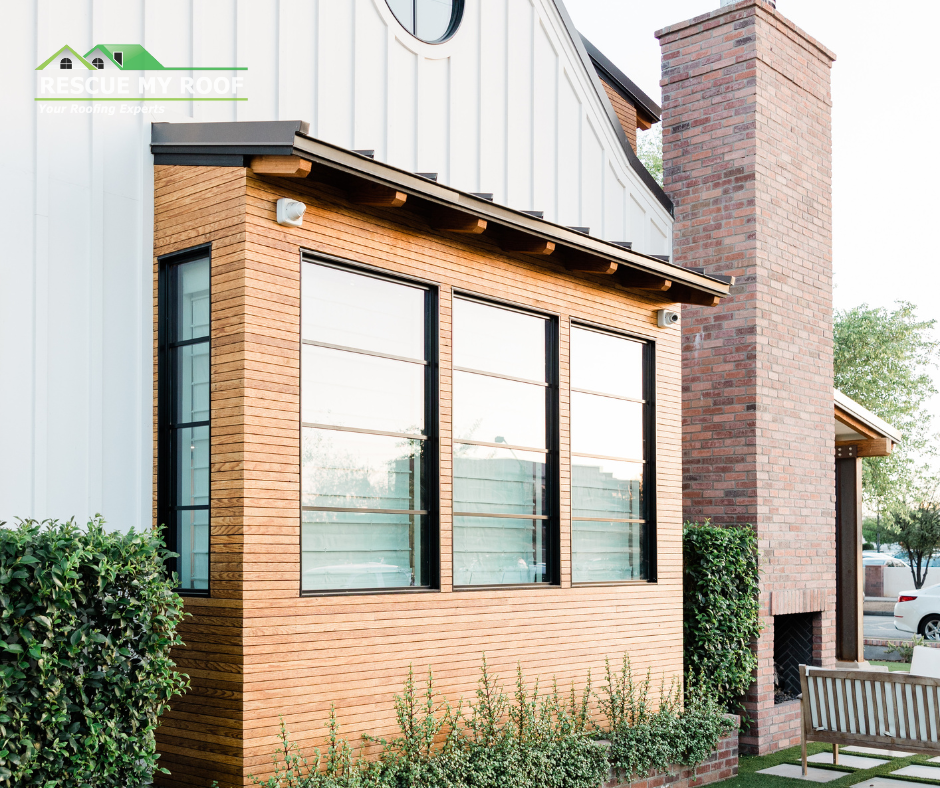Choosing the Best Siding Material for Your Home: A Complete Guide
Choosing the right siding material for your home is a major decision that impacts both the aesthetic appeal and the long-term durability of your property. With so many options on the market, it can be overwhelming to figure out which material is best suited to your home’s style, climate, and budget.
Rescue My Roof has been in the siding industry for over a decade, helping thousands of homeowners choose the right look for their homes. We understand how frustrating it can be to choose the right style for your home. We’re here to make it easier.
This guide will break down the most popular siding materials and key factors to consider when making your decision. Ultimately, you’ll know which siding option is right for your home.
The Top 6 Siding Options
Before choosing a siding material, you should consider all of your options. Here are the top 6 most popular siding choices:
1. Vinyl Siding
One of the most popular and affordable choices, vinyl siding is made from polyvinyl chloride (PVC) and is known for its versatility and low maintenance. Here’s why it’s a top pick for many homeowners:
:strip_icc()/can-you-pain-vinyl-siding-a2d8b31c60b541c69c1aa4a0ddff501f.jpg)
- Pros:
- Affordable and widely available
- Comes in a variety of colors and textures
- Resistant to rot, insects, and moisture
- Requires minimal maintenance (occasional cleaning)
- Cons:
- May crack or warp in extreme temperatures
- Limited to certain styles and colors
- Repairs can be noticeable if matching colors fade over time
2. Fiber Cement Siding
Fiber cement siding is made from a mix of cement, sand, and cellulose fibers. It’s known for its durability and ability to mimic other materials like wood or stone.

- Pros:
- Highly durable and resistant to fire, pests, and rot
- Can be painted and comes in many styles, including wood-look designs
- Holds up well in extreme weather conditions
- Cons:
- More expensive than vinyl siding
- Requires occasional repainting (if painted)
- Heavier and more difficult to install, which may increase labor costs
3. Wood Siding
Wood siding offers a natural, classic appearance and is available in different forms like shingles, shakes, and planks. It’s often used in historic homes or for those who want a more rustic, timeless look.

- Pros:
- Beautiful, natural appearance with a variety of finishes
- Eco-friendly and biodegradable
- Can be easily customized and painted in any color
- Cons:
- Requires regular maintenance (painting, sealing) to prevent rot and insect damage
- Vulnerable to moisture, termites, and fire
- More expensive to install and maintain over time
4. Aluminum Siding
Aluminum siding has been around for decades and is a low-maintenance option that provides excellent protection against weather, especially in coastal regions prone to salty air.
- Pros:
- Rust-resistant and waterproof, ideal for wet climates
- Fire-resistant and non-combustible
- Low maintenance and can be painted easily
- Cons:
- Can dent easily and show scratches or marks
- Doesn’t offer as much insulation as other materials
- Limited in aesthetic options compared to newer siding materials
5. Brick or Stone Veneer
For homeowners seeking a more upscale, elegant look, brick or stone veneer offers a classic appearance with added durability. While not made from solid brick or stone, these veneers still provide the same aesthetic at a fraction of the cost.
- Pros:
- Extremely durable and resistant to weather, fire, and pests
- Provides excellent insulation and energy efficiency
- Timeless, high-end appearance
- Cons:
- Higher upfront costs for both materials and installation
- Heavy materials may require structural reinforcements
- Requires skilled labor to install correctly, adding to the expense
6. Stucco Siding
Stucco is a traditional siding material made from a mixture of sand, lime, and cement. It’s popular in warmer, drier climates and is commonly found in southwestern or Mediterranean-style homes.
- Pros:
- Energy-efficient due to its insulation properties
- Fire-resistant and durable in dry climates
- Offers a unique, textured appearance that adds curb appeal
- Cons:
- Not ideal for areas with heavy rainfall or high humidity, as it can crack
- Requires regular maintenance to repair cracks and prevent water intrusion
- Can be more expensive to install compared to vinyl or aluminum
Key Factors to Consider When Choosing Siding
Now that you know your options, how do you choose between them? Here are some essential factors to consider:
Climate
Your home’s location and climate should be a major factor in choosing siding material. Homes in areas prone to heavy rainfall, snow, or extreme heat will need materials that can withstand moisture, temperature fluctuations, and high winds.
For example, fiber cement or metal siding may perform better in these conditions compared to wood. Evaluate your local climate before deciding on a material.
Durability and Maintenance
Different siding materials require varying levels of upkeep. If you’re looking for a low-maintenance option, vinyl, fiber cement, or aluminum may be the way to go.
Wood and stucco, while beautiful, require more frequent maintenance, such as painting or sealing, to prevent damage.
Vinyl siding, one of the most popular siding materials in the U.S., is a great choice for homeowners who want a low-maintenance material. Ultimately, you’ll have to decide how much upkeep you’d like to do.
Aesthetic and Style
The look of your siding will have a big impact on your home’s curb appeal. Consider the architectural style of your home and your personal preferences.
Do you want a classic, rustic look? Wood siding or fiber cement with a wood-grain finish may be best. For a sleek, modern home, metal siding or a smooth stucco finish could be ideal.
Energy Efficiency
Siding materials play a role in your home’s insulation. Materials like fiber cement, insulated vinyl, and brick or stone veneer provide better energy efficiency, which can help reduce heating and cooling costs over time.
Budget
Cost is always a significant factor when choosing siding. While vinyl is one of the most affordable options, high-end materials like brick veneer or stone can be much more expensive.
Be sure to factor in not just the material cost, but also installation and long-term maintenance expenses.
Environmental Impact
If sustainability is important to you, consider eco-friendly siding options.
Wood siding is biodegradable and renewable, while fiber cement uses natural materials like sand and cellulose fibers. Aluminum siding is also recyclable, making it a greener choice.
Choosing the Siding That Fits Your Home’s Needs
Choosing the right siding material for your home is a balance between aesthetics, durability, energy efficiency, and cost. There is no one-size-fits-all solution—your climate, budget, and personal taste will all influence the best option for your home.
By considering the pros and cons of each material and understanding your home’s unique requirements, you can make an informed decision that will enhance your home’s exterior for years to come.
If you’re unsure which siding material is best for you, consult with a professional siding contractor to help guide you through the process and ensure a beautiful, long-lasting result!
Learn more with “Siding and Extreme Weather: How to Protect Your Home’s Exterior” and “7 Things to Know Before Replacing Your Siding (Materials, Pricing & More).”
Is your siding dull, old, or leaking? Rescue My Roof can help. Contact us today to get a free siding estimate.


